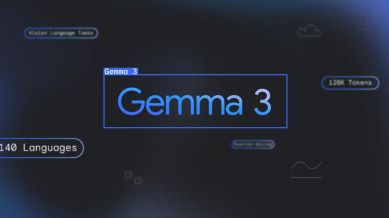Technology on smartphone reviews, in-depth reports on privacy and security, AI, and more. We aim to simplify the most complex developments and make them succinct and accessible for tech enthusiasts and all readers. Stay updated with our daily news stories, monthly gadget roundups, and special reports and features that explore the vast possibilities of AI, consumer tech, quantum computing, etc.on smartphone reviews, in-depth reports on privacy and security, AI, and more. We aim to simplify the most complex developments and make them succinct and accessible for tech enthusiasts and all readers. Stay updated with our daily news stories, monthly gadget roundups, and special reports and features that explore the vast possibilities of AI, consumer tech, quantum computing, etc.
What is Gemma 3, Google’s new lightweight AI model that can run on a single GPU?
Google claimed Gemma 3 outperformed Meta’s Llama-405B, OpenAI’s o3-mini, and DeepSeek-V3 in preliminary human preference evaluations on LMArena.

Google has released Gemma 3, the latest addition to its family of lightweight open models that are designed to run directly on phones, laptops, and other devices.
monthly limit of free stories.
with an Express account.
Gemma 3 models are capable of processing text and visual inputs but can only generate text outputs. The models are available in one billion, four billion, 12 billion, and 27 billion-parameter sizes, allowing developers to choose the model best suited to run their AI applications.
“The 27B model was trained with 14 trillion tokens, the 12B model was trained with 12 trillion tokens, 4B model was trained with 4 trillion tokens and 1B with 2 trillion tokens,” according to the Gemma 3 page on Hugging Face.
While Gemma 3 has been trained on a dataset of text data, Google did not specify the data sources. It also revealed that the weights of Gemma 3 are open-source and can be used by developers to build pre-trained variants and instruction-tuned variants of the small language model (SLM).
Google further claimed that Gemma 3 comes with a 128k-token context window that allows the model to understand larger amounts of information.
How Gemma 3 compares with other AI models
Google has claimed that Gemma 3 achieved a better benchmark score than Meta’s Llama-405B model as well as OpenAI’s o3-mini and DeepSeek-V3 in preliminary human preference evaluations on LMArena, an open platform developed by UC Berkley researchers for crowdsourced AI benchmarking.
Gemma 3 can be used to build AI applications that analyse images, text, and short videos. It can also handle linguistic tasks as Gemma 3 supports over 35 languages, with pretrained support for over 140 languages. In addition, developers can use Gemma 3 to build AI tools that automate tasks and offer AI agent-based capabilities due to its structured outputs and function calling support.
Gemma 3 is available for download through platforms such as Kaggle and Hugging Face. It is also accessible via Google Studio.
“Gemma 3 offers multiple deployment options, including Vertex AI, Cloud Run, the Google GenAI API, Iocal environments and other platforms, giving you the flexibility to choose the best fit for your application and infrastructure,” the company said.
The series of models can be further trained and fine-tuned using platforms such as Google Colab, Vertex AI, and even on gaming GPUs, as per the company. “Gemma 3 ships with a revamped codebase that includes recipes for efficient fine-tuning and inference,” it added.
What is ShieldGemma 2?
Alongside the release of Gemma 3, Google announced the rollout of its four billion parameter-size AI safety tool called ShieldGemma 2.
ShieldGemma 2 can be used to attach labels such as dangerous content, sexually explicit, and violence to AI-generated images. Google claimed that ShieldGemma 2 can be integrated with any other tool used by developers, with options for further customisation available.